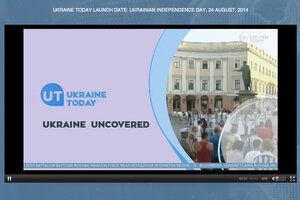Ukraine Today jumps into the Ukraine-Russia media war
The world's newest 24-hour TV channel aims to offer a Ukrainian perspective to the English-language media. But will it find an audience?

A screen capture from Ukraine Today's web-hosted live feed.
uatoday.tv
One news report describes the life-changing effect of the EuroMaidan protests on European journalists who covered them. Another features the plight of the Yazidis in northern Iraq. A third cites Russia lowering its economy forecast amid sanctions from the West. And in between, professional promos herald "Ukraine's European ambitions."
This is the world’s newest 24-hour English-language network, Ukraine Today, which launched on Ukraine's Independence Day yesterday.
Amid the ongoing information war between Russia and Ukraine, the new channel promises to take viewers “beyond the headlines” with commitment to "Honesty," "Freedom," and "Rule of Law." But even with a Ukrainian perspective largely absent from the English-speaking media, it is unclear whether there is space for yet another player on an already crowded playing field.
'An independent picture for Ukraine'
Ukraine Today promises to offer a fresh and deep look at Ukraine with a focus on European Union integration as well as relations with Russia. The channel features punchy music between segments and has aired pieces on the difficulty Russian tourists face getting to Crimea and NATO accusations of Russia sending its troops to fight in Ukraine.
Part of the 1+1 Media group owned by Ukrainian oligarch Ihor Kolomoisky, the channel and its name have already raised questions about whether it will be similar to Russia’s Kremlin-backed RT network, formerly known as Russia Today.
Ukraine Today’s executive producer, Tanya Pushnova, told the Monitor the channel will be editorially independent and its scope will reach beyond Ukraine with a focus on other eastern European countries as well as the Baltic States. And she dismisses the similarity between Ukraine Today and its Russian counterpart. “Russia Today isn’t the only place that uses the word ‘today,’" she says. "USA Today does also.”
Ms. Pushnova says discussions about launching a channel began after protests against former Ukrainian President Viktor Yanukovych gained momentum.
“We saw the need for an independent picture for Ukraine and the neighborhood in the wintertime,” says Pushnova. “We really hope Europe will get an alternative channel of information about one of the biggest countries in Europe.”
Finding an audience for Ukraine Today will be key to its survival, but Yevhen Fedchenko, the director of the journalism program at the National University of Kyiv Mohyla Academy, isn’t sure where the channel will fit internationally.
“I am not sure there will be a huge interest among the world audience to watch all of this,” says Mr. Fedchenko. "I am afraid to some extent it can be wasted time and money and effort."
At the same time, he notes that Ukraine has had a difficult time explaining its perspective to the world with very few Ukrainian journalists publishing in English or other languages.
The ongoing information war
The information war between Russia and Ukraine has reached a fever pitch with apocryphal stories circulating in Russian media about Ukrainians crucifying a young boy in the eastern city of Slaviansk. Russia cut off Ukrainian TV channels when it illegally annexed Crimea in March and last week Ukraine blocked 14 Russian channels for “broadcasting propaganda of war and violence.”
Pushnova has worked as a journalist for a decade and says even during the Orange Revolution in 2004, Russian media aired negative reports regarding Ukraine. Now, however, she says reports have reached a whole new level.
“It’s a situation where black is called white and white is called black…. We don’t call the people who work in Russia colleagues,” she says.
Ellen Mickiewicz, an expert on Russian media and leadership and a professor of political science at Duke University, says Russian media have stressed that the Ukrainian government in Kiev is fascist. They employ images of Nazis from World War II and wounded young children, often times set to dramatic music, in their narratives against the Ukrainian government.
“I have not seen this level of emotion, of disgust, of atrocity of fear-mongering, it’s that emotional element that I think is in the main news,” says Ms. Mickiewicz. “And that I think is much more incendiary than anything I’ve seen before.”
Reporting on Ukraine
How Ukraine Today will report on the current situation in Ukraine and relations with Russia remains to be seen.
“There’s a great temptation when you go international for puff pieces and I think that will be the big question,” says Mickiewicz. “Will dissenting voices be given enough time? What will they cover and bring in from eastern Ukraine and what will be seen?”
With most people in Russia still receiving news via TV, Ukraine Today will be at a disadvantage because it will only be available online or by satellite, a luxury Mickiewicz says most Russians can’t afford.
Ukraine Today plans to enter the American and Canadian markets next year and it also hopes to eventually broadcast in the Russian language.

